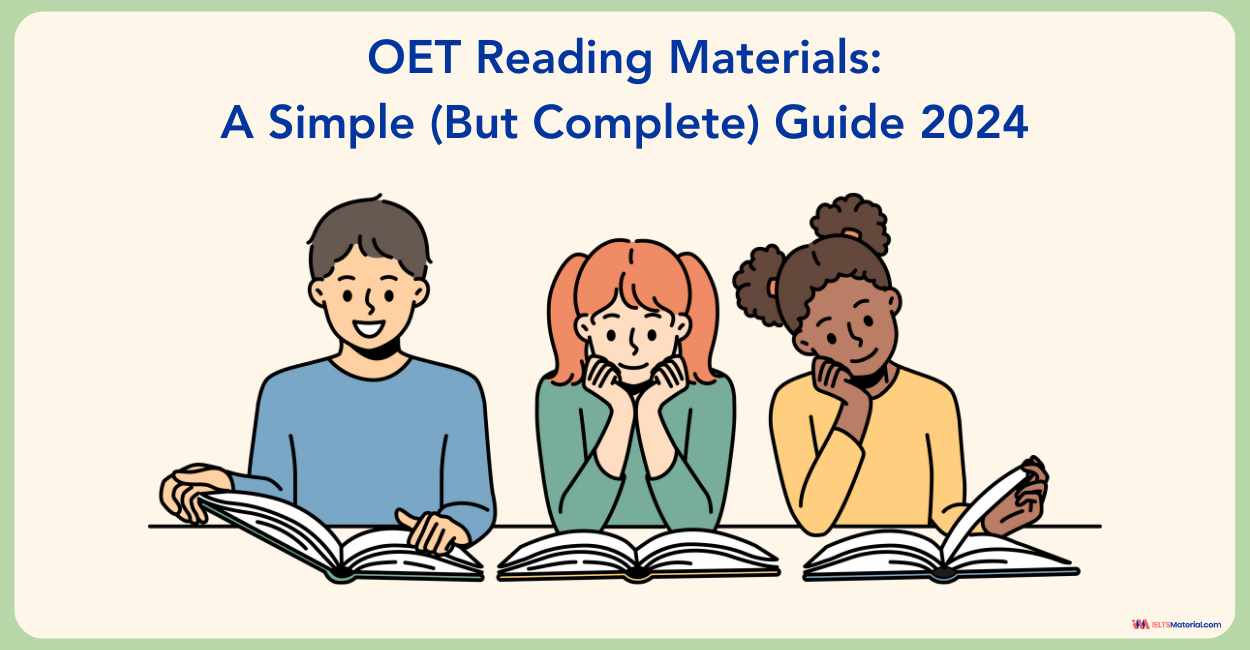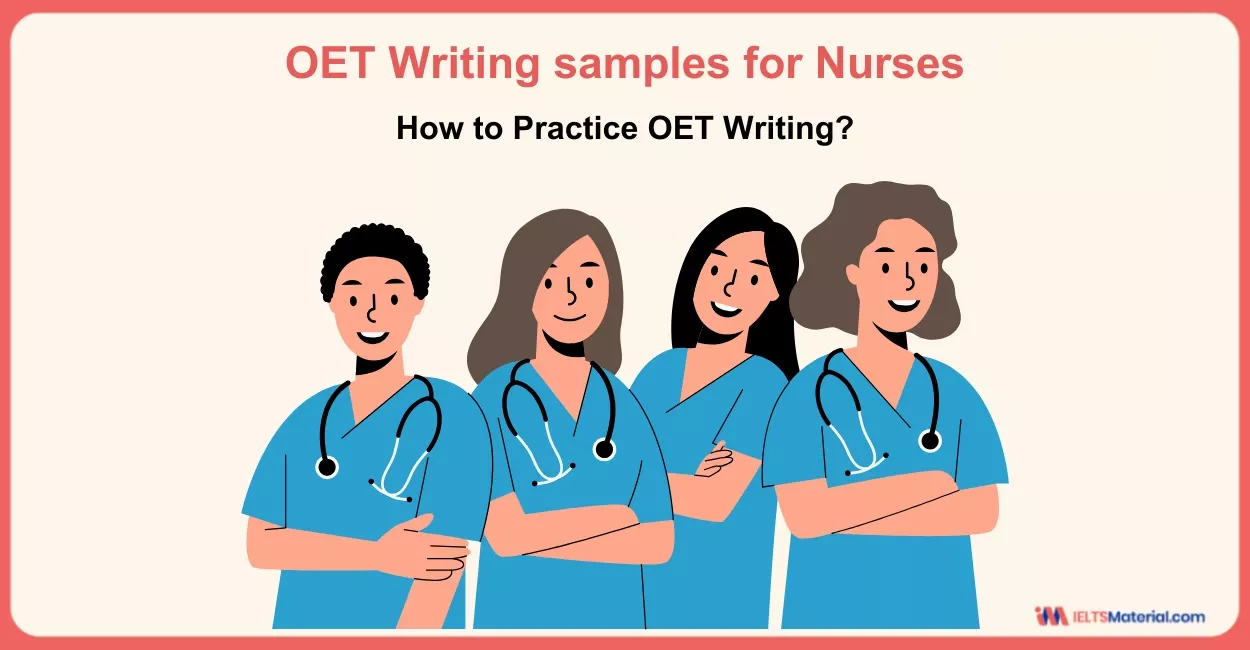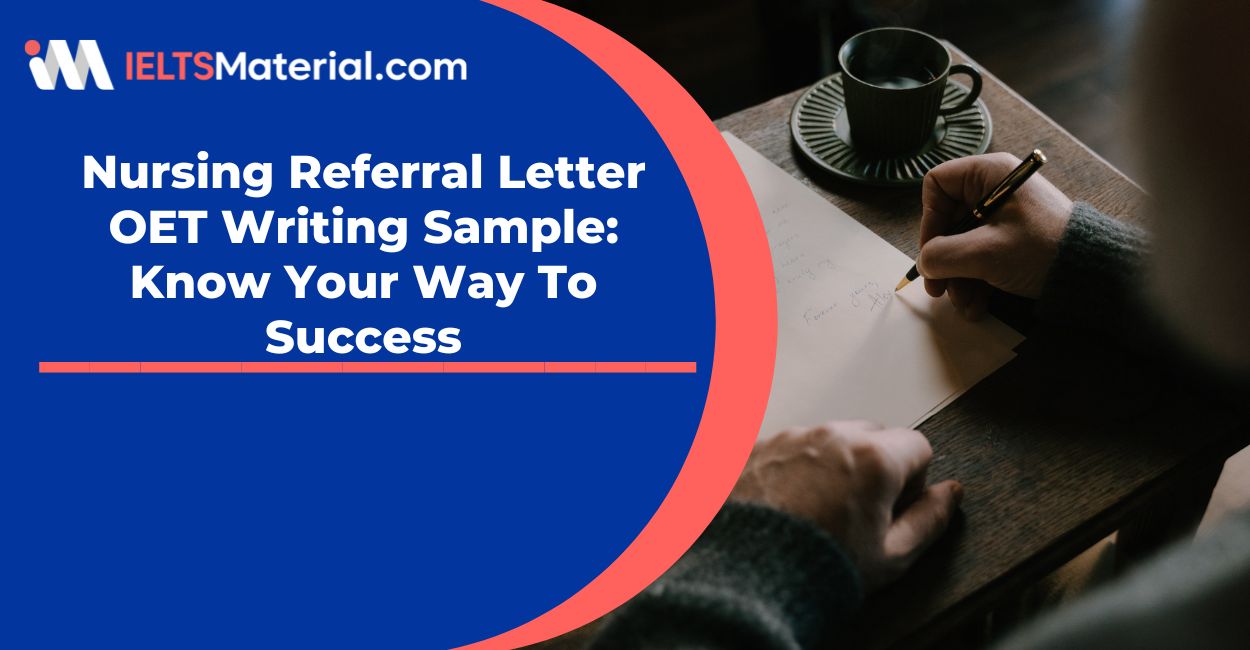OET Listening: Format, Score, Samples, Practice Tests & Tips
10 min read
Updated On
-
Copy link
OET Listening is designed to evaluate the listening skills of medical professionals from non-English speaking countries. Know what listening in OET means, how it is scored and get OET Listening samples for preparation to achieve your desired score.
Table of Contents

Limited-Time Offer : Access a FREE 10-Day IELTS Study Plan!
The OET Listening exam assesses the ability of healthcare professionals to understand spoken English in medical settings. Unlike the IELTS exam, this test is designed specifically for doctors, nurses, pharmacists, physiotherapists, and other healthcare workers who plan to work in an English-speaking environment. A strong OET Listening score is crucial to achieving your professional registration and career goals. The topics are of generic healthcare interest and the task is alike and uniform for all the medical professions covered under the OET exam.
This guide will cover everything you need to know about OET Listening, including its test structure, scoring system, sample practice materials, and expert tips to boost your preparation.
OET Listening Test Structure
The Listening test of the OET exam lasts for approximately 40 minutes and consists of three parts. There are 42 questions in total and the test is designed to reflect real-life healthcare conversations and interactions.

Sections of the OET Listening
The OET Listening subtest has three parts, i.e., Part A, Part B and Part C. They have been curated to evaluate a range of listening skills, like the ability to comprehend certain details, information, gist or perception, or the speaker’s objective. Let’s see some pointers on each of these subsections of OET Listening.
In the table below, you will get a clear breakdown of the OET exam pattern, helping you understand what to expect in each section of the OET Listening sub-test:
|
OET Listening Part |
Audio Details |
Duration |
Question Type |
Number of Questions |
Preparation Time |
|---|---|---|---|---|---|
|
Part A: Consultation Extracts |
Two recordings featuring a healthcare professional and a patient |
4-5 minutes each |
Note completion |
12 questions per extract |
N/A |
|
Part B: Workplace Extracts |
Six short workplace conversations (one or two speakers) |
~45 seconds per extract |
One 3-option multiple-choice question per audio |
6 questions total |
15 seconds per audio |
|
Part C: Presentation Extracts |
Two recordings (professional development audio like a lecture or interview) |
4-5 minutes each |
Six 3-option multiple-choice questions per audio |
12 questions total |
90 seconds per audio |
OET Listening Scoring System
The OET Listening score is marked out of 42. The raw score is converted into a scaled grade (A to E). Here’s an approximate score conversion:
|
Raw Score (out of 42) |
OET Grade |
CEFR Level |
Performance Description |
|---|---|---|---|
|
38 - 42 |
A |
C2 |
Excellent understanding of healthcare-related spoken English |
|
30 - 37 |
B |
C1 |
Good comprehension with minor inaccuracies |
|
23 - 29 |
C+ |
B2 |
Adequate understanding but with some errors |
|
18 - 22 |
C |
B2 |
Limited comprehension; may miss key details |
|
Below 18 |
D/E |
Below B2 |
Poor understanding of medical conversations |
Most healthcare regulatory bodies (e.g., GMC, NMC, AHPRA) require a B (minimum 30/42) in OET Listening.
Check Out - OET Score Calculator
Assessment of Listening Ability in OET
Each part of the OET Listening sub-test assesses your ability to listen for specific information, understand opinions, and follow medical conversations accurately. For example:
- Part A of the Listening test evaluates one on the basis of their identification of specific information in a health consultation and requires one to complete the notes.
- Part B assesses one based on their ability to pick up and understand the detail, gist, opinion or purpose of short extracts from the healthcare domain.
- Part C assesses one on the basis of their ability to understand the recorded presentation or interview in a generic medical context or a workplace situation.
Generally, those who get the liability to mark the Listening sub-test are experienced and competent. The responses are evaluated by keeping a comprehensive marking guide in mind. If any of the answers come unanticipated or complicated, they get referred to a sub-group of senior evaluators for suggestions.
The answers for Part A are double-marked by trained OET evaluators. To avoid any conflict, random answers are assigned to different examiners and they use a detailed marking guide for assessing the test papers. In terms of Part B and Part C answers, they are computer scanned and scored automatically.
OET Listening Samples for Practice
Let’s have a look at an OET Listening practice material. Check out OET Listening samples for more OET Listening exercises for practice.
Listen to the Audioand answer the following questions.
Part A
In this part of the test, you'll hear two different extracts. In each extract, a health professional is talking to a patient.
For questions 1-24, complete the notes with information that you hear.
Now, look at the notes for extract one.
Extract 1: Questions 1-12
You hear a physiotherapist talking to a new patient called Ray Sands. For questions 1-12, complete the notes with a word or short phrase that you hear.
You now have thirty seconds to look at the notes.
Patient - Ray Sands
18 months ago - back injury sustained (lifting 1 …………………)
1 year ago - sciatica developed
6 months ago - clear of symptoms
Last month - recurrence of symptoms
Patient’s description of symptoms
- pain located in 2 …………………
- pain described as 3 …………………
- loss of mobility
- problems sleeping
- mentions inability to4 ………………… as most frustrating aspect
- 5 ………………… sensation (calves)
- general numbness in affected area
Occupation - 6 ………………… (involves travel/some manual work)
Initial treatment
- prescribed NSAIDs
- application of 7 ………………… (provided some relief)
Referrals
- 8 ………………… (briefly)
- sports injury specialist for manipulation and exercise programme
Further treatment
- epidural injections
- 9 …………………
- electrical impulses
- decided not to try 10 …………………
- patient attributes recovery to 11 …………………
Previous diagnosis
- sciatica probably related to 12 …………………
- reports no history of pain in buttocks
Extract 2: Questions 13-24
You hear a consultant dermatologist talking to a patient called Jake Ventor.
For questions 13-24, complete the notes with a word or short phrase that you hear.
You now have thirty seconds to look at the notes.
Patient - Jake Ventor
Reason for referral - skin lesion
Patient’s description of condition
- on the 13 ………………… of his left hand
- preceded by 14 …………………
- then 15 ………………… form and join up
- surrounding erythema
- GP describes appearance of lesion as 16 …………………
- normally resolves within two weeks
History of condition
- first experienced in 1990s when living in China
- also had a lesion on his 17 ………………… – never recurred there
- recurs regularly on different parts of his left hand
- not becoming more 18 …………………
- no apparent link to general state of health, 19 ………………… or stress
Medical history
- 20 ………………… on lower back in 2006 – no sign of recurrence
- reports no history of 21 …………………
Information given
- advised that 22 ………………… was unlikely to be effective
- told him to take care if the skin is 23 …………………
Outcome
- says his quality of life isn’t affected
- a 24 ………………… will be arranged
That is the end of Part A. Now look at Part B.
Part B
In this part of the test, you’ll hear six different extracts. In each extract, you’ll hear people talking in a different healthcare setting.
For questions 25-30, choose the answer (A, B or C) which fits best according to what you hear. You’ll have time to read each question before you listen. Complete your answers as you listen.
Now look at question 25.
25 You hear a nurse briefing her colleague about a patient. What does she warn her colleague about?
A The patient is allergic to some types of antibiotics.
B Care must be taken to prevent the patient from falling.
C Oxygen may be needed if the patient becomes breathless.
26 You hear the manager of a care home for the elderly talking to the nursing staff. He says that errors in dispensing medication to patients usually result from
A interruptions while calculating dosages.
B a failure to check for patients’ allergies.
C administering drugs late in the day.
27 You hear part of a morning briefing on a hospital ward. What is the plan for the patient today?
A Her emotional state will be carefully observed.
B She will be transferred to a more specialised unit.
C A social worker will come to see what help she needs.
28 You hear part of an ante-natal consultation at a GP practice. What does the patient want to know about?
A the advisability of a home birth
B ways of avoiding post-natal depression
C what painkillers might be available during labour
29 You hear a trainee doctor telling his supervisor about a problem he had carrying out a procedure. The trainee feels the cause of the problem was
A treatment administered previously.
B the patient’s negative reaction.
C inappropriate equipment.
30 You hear a doctor talking to a teenage boy who has a painful wrist. The doctor wants to establish whether
A a fracture may be misaligned.
B the swelling may be due to a sprain.
C there may be more than one bone affected.
That is the end of Part B. Now look at Part C.
Part C
In this part of the test, you’ll hear two different extracts. In each extract, you’ll hear health professionals talking about aspects of their work.
For questions 31-42, choose the answer (A, B or C) which fits best according to what you hear. Complete your answers as you listen.
Now look at extract one.
Extract 1: Questions 31-36
You hear an interview with a cardiologist called Dr Jack Robson, who’s an expert on Chagas disease. You now have 90 seconds to read questions 31-36.
31 Why does Dr Robson regard Chagas as a neglected disease?
A because of the social groups it mainly affects
B because patients often don’t realise they’re infected
C because its impact is severe in a relatively small number of cases
32 Dr Robson says that concerns over Chagas in the USA are the result of
A a rise in the number of people at risk of being infected with the disease.
B a greater awareness of how many people there have the disease.
C an increased prevalence of the insect which carries the disease.
33 A patient called Marisol recently asked Dr Robson to test her for Chagas because
A she was worried about the health of any children she might give birth to.
B she wanted to know whether it was safe for her to donate blood.
C she thought she had symptoms associated with the disease.
34 What problem does Dr Robson identify in the case of a patient called Jennifer?
A an unwillingness to accept that she was ill
B an inability to tolerate the prescribed medicine
C a delay between the initial infection and treatment
35 What does Dr Robson say about his patient called Juan?
A The development of his illness was typical of people with Chagas.
B An incorrect initial diagnosis resulted in his condition worsening.
C The medication he took was largely ineffective.
36 Dr Robson thinks the short-term priority in the fight against Chagas is to
A increase efforts to eliminate the insects which carry the parasite.
B produce medication in a form that is suitable for children.
C design and manufacture a viable vaccine.
Now look at extract two.
Extract 2: Questions 37-42
You hear an occupational therapist called Anna Matthews giving a presentation to a group of trainee doctors. You now have 90 seconds to read questions 37-42.
37 Anna says that the main focus of her work as an occupational therapist is
A designing activities to meet the changing needs of each patient.
B making sure she supports patients in reaching their goals.
C being flexible enough to deal with patients of all ages.
38 When Anna first met the patient called Ted, she was
A unable to identify completely with his attitude.
B optimistic that he would regain full mobility.
C mainly concerned about his state of mind.
39 Because Ted seemed uninterested in treatment, Anna initially decided to focus on
A what he could achieve most easily.
B allowing him to try and help himself.
C making him come to terms with his injuries.
40 Anna feels that, in the long term, her therapy helped Ted because
A it led him to become less emotional.
B it made him appreciate the need for patience.
C it showed him there was something to work towards.
41 Anna describes the day Ted had his plaster casts removed in order to
A demonstrate how slow any progress can seem to patients.
B illustrate the problems caused by raising a patient’s hopes.
C give advice on what to do when patients experience setbacks.
42 Anna suggests that when patients like Ted recover enough to go home, they are often
A too ambitious in what they try to achieve initially.
B able to build on the work of the occupational therapist.
C held back by the over-protective attitude of family members.
That is the end of Part C.
You now have two minutes to check your answers.
THAT IS THE END
Quick Tips for OET Listening
Here are some OET Listening tips to follow to ensure higher marks in the test:
- Read questions before hearing the audio - Before you begin listening to the audio, make sure you thoroughly navigate through all of the questions. It will assist you in finding keywords and phrases that will further help you form answers.
- Listen cautiously - Listening cautiously is the key to scoring higher on the listening test. Thus, it is essential you pay rapt attention to the audio. Also, make sure you are concentrating on the keywords when listening attentively.
- Speak up if you couldn’t hear the audio - Technical glitches can come everywhere. There could be times when you might not be able to hear the audio properly. If that happens, you must inform the invigilator to get the issue fixed.
- Pay attention to the order of the audio - One thing to keep in mind is that the audio of this test goes in a sequence. It is structured in the same manner and order as the questions. Thus, it would be best if you didn’t face any confusion while finding answers to a specific question.
- Learn abbreviations - There are a variety of fields that will have plenty of abbreviations, such as the healthcare sector. Hence, you must familiarize yourself with the abbreviations and know where and when they should be used. As part of the test, you will have to take notes on the patient. Using abbreviations will help you save time and write faster in such a scenario.
- Avoid getting distracted - When listening to the audio, it is easy to get distracted. However, any intrusion can lead to missed answers, keywords or phrases. So, make sure you listen to the audio with complete concentration.
OET Listening is a critical part of the exam that assesses your ability to understand healthcare-related conversations. By practicing with official tests, improving medical vocabulary, and honing active listening skills, you can achieve a B or higher with confidence. In case you need guidance, you can take OET Trainingto prepare better without wasting precious time.
Also Check:
Frequently Asked Questions
What is the OET Listening task all about?
What is the total time for the OET Listening task?
How many questions are there in each part of the OET Listening?
What are the types of questions asked in the OET Listening?
Is there any time allotted to go through the responses I have provided?
Other OET Exam Related Articles

Start Preparing for IELTS: Get Your 10-Day Study Plan Today!
Recent Articles

Kasturika Samanta

Haniya Yashfeen

Kasturika Samanta





Post your Comments